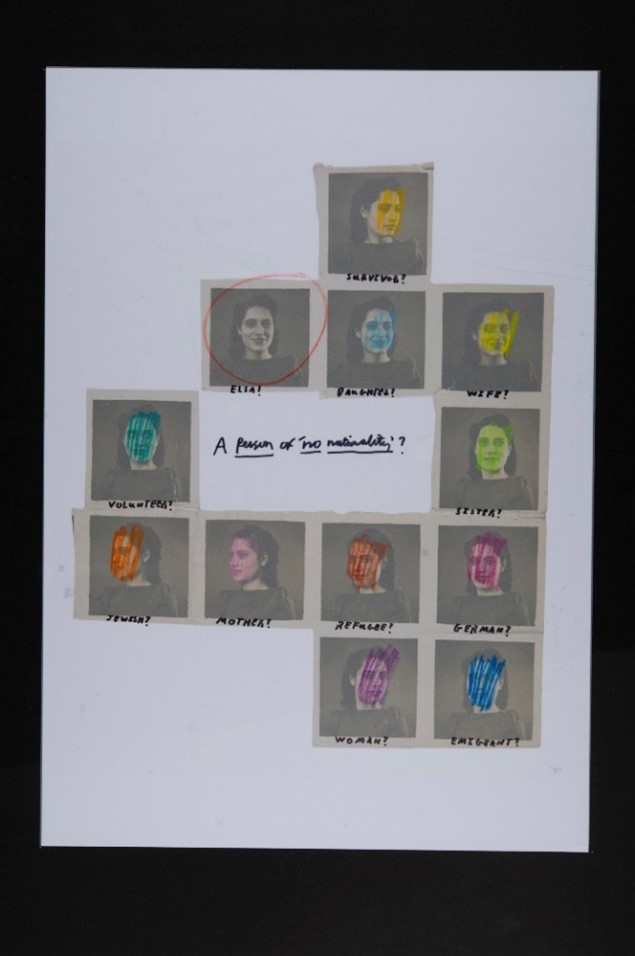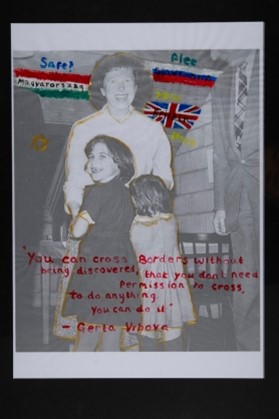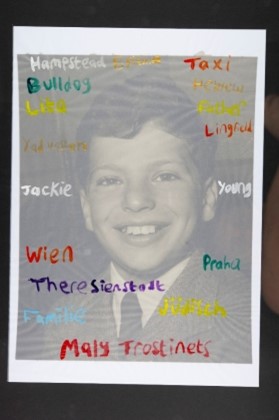Just before lockdown in late February 2020, myself and a group of fellow Holocaust Educational Trust Ambassadors participated in and created a takeover exhibition at the Jewish Museum London. The project was called ‘Your Legacy and Me’ and our aim was to explore the role art plays in the legacy of Holocaust remembrance. Over two days, we attended a variety of sessions and workshops and were able to explore the Jewish Museum, before creating our own ‘legacy art’ inspired by the testimonies of four inspiring Holocaust survivors.
Day One
For our first workshop, Shereen Hunte, Education Officer at the Jewish Museum London enabled us to examine artefacts connected to the Holocaust that sit within their collection. Objects included a yellow Star of David badge that Jewish individuals were forced to wear on their clothing as a means of identification, as well as a traditional spice box used for the prayers at the end of the Sabbath (Judaism’s day of rest on the seventh day of the week i.e. Saturday). These objects helped us to understand the importance and significance of preserving physical objects as part of understanding the historical legacy of the Holocaust.
 Charlotte Salomon, Leben? Oder Theater? Ein Singspiel [Life? or Theatre? A Play with Music], 1941-42, Collection Jewish Historical Museum, Amsterdam. © Charlotte Salomon Foundation, Charlotte Salomon ®
Charlotte Salomon, Leben? Oder Theater? Ein Singspiel [Life? or Theatre? A Play with Music], 1941-42, Collection Jewish Historical Museum, Amsterdam. © Charlotte Salomon Foundation, Charlotte Salomon ®
In the afternoon, we were able to tour the exhibition that would inspire our ‘legacy art’. The exhibition included pieces created by German-Jewish artist Charlotte Salomon who was tragically killed at Auschwitz-Birkenau in 1943 and featured over 200 small gouaches she’d created during the early 1940s when she was in hiding from the Nazis, and spanned her complicated family history, the rise of Nazis and her exile to France. I found the level of personal life detail in each gauche to be extraordinary. These details enabled us to learn about Charlotte and who she was as a person, really humanising the Holocaust. A fellow Ambassador, Chloe Milton said that the exhibition enabled her to ‘connect on an individual level and understand more about who Charlotte was as a person’. This insight is an extremely important factor to consider when we learn about the Holocaust, remembering the individuals rather than the statistics.
 Reflecting on our first day
Reflecting on our first day
After exploring the exhibition, we heard from Holocaust survivor, Jackie Young, who was deported from a Jewish orphanage to in the Theresienstadt Ghetto at just nine months old. Following liberation, he came to the UK on a British Government initiative allowing 1,000 young Holocaust survivors to settle in Britain, commonly known as ‘The Boys’ and he was adopted when he was six years old. Jackie shared his experiences of growing up in England unaware of his background, and I found it moving to hear about his later struggle between ‘dual identities’ when he learned of his experience and connected with other Holocaust survivors.
Day Two
We started our second day with a session with JAMI’s Education Manager Phillippa Carr, in which we explored the meaning of ‘legacy’ and how we could reflect this in our pieces.
I wanted to reflect how Elsa had a complex human identity and personality as we all do with multiple facets, defying the dehumanisation that the Nazis tried to force on her and others.
Following this session, we were divided into four groups – with each basing their artwork on one of four Holocaust survivors (Elsa Shamash, Greta Vrbova, Solly Irving and Jackie Young). We were given the story of our survivor and a series of pictures from their lives on which to base our piece. Once we chose the photograph that resonated most strongly with us, we overlaid these with tracing paper and then painted or drew on the tracing paper. This creative style was in the inspired by Charlotte Salomon’s work. My piece (below) is based on Holocaust survivor Elsa Shamash’s experiences. I wanted to reflect how Elsa had a complex human identity and personality as we all do with multiple facets, defying the dehumanisation that the Nazis tried to force on her and others.
 Starting to draw on tracing paper
Starting to draw on tracing paper
Ambassador Billy Sumner created a piece on Jackie Young (below), which was inspired by Jackie’s experience of struggling with his identity after finding out he was a Holocaust survivor. Billy said he aimed to ‘represent both his [Jackie’s] life in the UK and the tragedy surrounding his family’s life in Vienna. The colour of the wording in this piece is based on Robert Plutchik’s emotional colour wheel. The lower half of the work uses words associated with Jackie’s past and birth family, including the name of the camps that he and his family were sent to.’ By contrast, Billy says that ‘the top half is about Jackie’s life in the UK, it features the name of his wife ‘Lita’ and the word ‘Father’ to pay recognition to his family.’ ‘and 'Yad Vashem’ in which Jackie visited to find out further information about of his birth family.’
 Elsa Shamash, by Michael Woodland
Elsa Shamash, by Michael Woodland
 Solly Irving, by Isobel King
Solly Irving, by Isobel King
 Greta Vrbova, by Chloe Milton
Greta Vrbova, by Chloe Milton
 Jackie Young, by Billy Sumner
Jackie Young, by Billy Sumner
The Opening of the Exhibition
Ambassadors will be carrying the torch and the information that is so valuable to save humanity for the future
After completion, our pieces were put on display at the Jewish Museum London at the beginning of March we all came back together to celebrate the opening of the exhibition. We were honoured to be joined again by Jackie Young who officially cut the ribbon, opening the exhibition to the general public. Reflecting on the project overall, Jackie reiterated how valuable this project and Ambassadors overall are: ‘Ambassadors will be carrying the torch and the information that is so valuable to save humanity for the future’. Shereen highlighted that ‘Now, more than ever, we have a duty to continue the legacy of Holocaust survivors’. She also praised our creativity to ‘create powerful pieces’ that reflected our responsibilities in being ‘legacy bearers’ to share the stories of Holocaust survivors and become their witnesses.
I found the experience gave me a new appreciation for how art can be a powerful and emotional medium for understanding experiences of the Holocaust. Working on the takeover exhibition has also helped me reflect on and contextualise my role as a Regional Ambassador for the Holocaust Educational Trust, especially as a ‘legacy bearer’ for the testimonies of survivors. Overall, I am grateful to the Holocaust Educational Trust, the Jewish Museum and JAMI for facilitating the takeover exhibition. Most importantly, I am very grateful to Holocaust survivors like Jackie Young, Elsa Shamash, Greta Vrbova and Solly Irving for sharing their stories so that future generations will learn from the tragedies of the past.
The Jewish Museum London is currently closed, but the pieces have been digitised and are available to view on their website here: jewishmuseum.org.uk/collections/online-collections/your-legacy-and-me/.
 Ambassadors who particpated in the 'Your Legacy and Me' Takeover project with Jackie Young during the celebration event for the opening of the exhibition.
Ambassadors who particpated in the 'Your Legacy and Me' Takeover project with Jackie Young during the celebration event for the opening of the exhibition.
